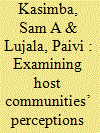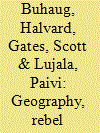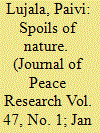|
|
|
Sort Order |
|
|
|
Items / Page
|
|
|
|
|
|
|
| Srl | Item |
| 1 |
ID:
110811


|
|
|
|
|
| Publication |
2012.
|
| Summary/Abstract |
Global warming is expected to make the climate warmer, wetter, and wilder. It is predicted that such climate change will increase the severity and frequency of climate-related disasters like flash floods, surges, cyclones, and severe storms. This article uses econometric methods to study the consequences of climate-induced natural disasters on economic growth, and how these disasters are linked to the onset of armed civil conflict either directly or via their impact on economic growth. The results show that climate-related natural disasters have a negative effect on growth and that the impact is considerable. The analysis of conflict onset shows that climate-related natural disasters do not increase the risk of armed conflict. This is also true when we instrument the change in GDP growth by climatic disasters. The result is robust to inclusion of country and time fixed effects, different estimation techniques, and various operationalization of the disasters measure, as well as for conflict incidence and war onset. These findings have two major implications: if climate change increases the frequency or makes weather-related natural disasters more severe, it is an economic concern for countries susceptible to these types of hazards. However, our results suggest - based on historical data - that more frequent and severe climate-related disasters will not lead to more armed conflicts through their effects on GDP growth.
|
|
|
|
|
|
|
|
|
|
|
|
|
|
|
|
| 2 |
ID:
086002


|
|
|
|
|
| Publication |
2009.
|
| Summary/Abstract |
This article empirically examines how natural resources affect the severity of armed civil conflict. It finds that drug cultivation in the conflict area is associated with less severe conflicts but that gemstone mining and oil and gas in the conflict zone production increase the severity of conflicts. Most severe are secessionist conflicts in regions with hydrocarbon production. Interestingly, oil and gas production outside the conflict zones is related to less severe conflicts. Measured at the country level, none of the resource variables has an effect on conflict severity. These results have four implications. First, availability of natural resources affects the severity of armed civil conflict. Second, the location of resources is crucial to their impact on conflict. Third, the type of resource matters. Above all, it seems that natural resources affect conflict severity by altering incentives for both the rebel group and the state
|
|
|
|
|
|
|
|
|
|
|
|
|
|
|
|
| 3 |
ID:
065629


|
|
|
| 4 |
ID:
180699


|
|
|
|
|
| Summary/Abstract |
Mining companies increasingly adopt trusts, foundations, and funds as part of their efforts to obtain and maintain a social license to operate and corporate social responsibility (CSR) strategies for community development. Using qualitative methodology, this article examined host communities’ perceptions of two mining company-financed trust funds in Ghana. The interviews revealed that although the community members considered some aspects of the trust funds positively, the trust funds’ overall objectives to promote meaningful participation of local community members and contribute to local development had not been met. Inadequate planning and needs assessments, and inflexibility in externally framed CSR practices that were unfavorable to the operational contexts, were among the key factors undermining the success of the trust funds.
|
|
|
|
|
|
|
|
|
|
|
|
|
|
|
|
| 5 |
ID:
090998


|
|
|
|
|
| Publication |
2009.
|
| Summary/Abstract |
Why do some armed civil conflicts last longer than others? Drawing on a contest success function model, we show that geographic factors (such as location, terrain, and natural resources) interact with rebel fighting capacity and together play a crucial role in determining the duration of conflict. Using precisely dated duration data in event history models and geographic data for the conflict location, we find that conflicts located at considerable distance from the main government stronghold, along remote international borders and in regions with valuable minerals last substantially longer. In addition, we find that rebel military capacity in its own right increases the prospects of a civil conflict ending within a short time period. Our findings imply that the distances an army must travel to project power, rebel fighting capacity, and characteristics of conflict region affect how a civil war is fought and who will prevail
|
|
|
|
|
|
|
|
|
|
|
|
|
|
|
|
| 6 |
ID:
093599


|
|
|
|
|
| Publication |
2010.
|
| Summary/Abstract |
Why is armed civil conflict more common in resource-dependent countries than in others? Several studies have attempted to unravel mechanisms on why natural resources are linked to armed conflict, but no coherent picture has yet emerged. This article seeks to address this puzzle by concentrating on the issue of how rebel access to natural resources affects conflict. It uses data on gemstone and hydrocarbon localities throughout the world and controls for the spatial and temporal overlap of resources and conflict. The results show that the location of resources is crucial to their impact on conflict duration. If resources are located inside the actual conflict zone, the duration of conflict is doubled. Interestingly, oil and gas reserves have this effect on duration regardless of whether there has been production or not. In addition, a country-level analysis suggests that oil production increases the risk of conflict onset when located onshore; offshore production has no effect on onset. These results support the assertion that natural resources play a central role in armed civil conflicts because of the incentives and opportunities they present for rebel groups.
|
|
|
|
|
|
|
|
|
|
|
|
|
|
|
|
|
|
|
|
|